Select a ticket option
Kisimul castle.
Castlebay, Isle of Barra, HS9 5UZ
- 01871 810 313
Kisimul Castle, seat of the chief of the Macneils of Barra, tells us of the nature of Gaelic lordship in the Middle Ages. Caisteal Chiosmuil, the island stronghold’s Gaelic name, means ‘castle of the rock of the small bay’.
It’s said that the Macneils settled in Barra in the 11th century, but it was only in 1427 that Gilleonan Macneil was recorded as the first lord. He probably built the castle that dominates the rocky islet, and in its shadow a crew house for his personal galley and crew.
The Macneils were a seafaring clan. A descendant, ‘Ruari the Turbulent’, was arrested for piracy of an English ship during James VI’s reign in the later 1500s.

The Macneils of Barra
The Macneils of Barra claimed Irish descent from the legendary Niall of the Nine Hostages, high king of Ireland in the 5th century and great-grandfather of St Columba.
By the 1400s, their clan chief was part of an elite group of lesser lords who were members of the Council of the Isles. This body advised the MacDonalds, Lords of the Isles, usually meeting at Finlaggan, on Islay.
The Macneils didn’t emerge as lords of Barra until Lord Alexander MacDonald granted the island to Gilleonan Macneil in 1427 – but they may have had some control over it in earlier medieval times.
Heavy debts forced the Macneil chiefs to sell Barra in 1838. But a descendant, Robert Lister Macneil, the 45th Chief, bought the estate in 1937, and set about restoring his ancestral seat. It passed into state care in 2000.
An island stronghold
The castle built in the 1400s was originally a three-storey tower house, in which the clan chief lived. A curtain wall fringed the small rock on which Kisimul stood, and enclosed the small courtyard with its ancillary buildings.
Ancillary buildings included a:
- feasting hall
- tanist’s (heir’s) house
- gokman’s (watchman’s) house
Most of the buildings were restored in the 1900s, the tanist’s house serving as the family home of the Macneils.
A well near the postern gate is fed with fresh water from an underground seam. Outside the curtain wall, beside the original landing-place, are the foundations of the crew house, where the sailors manning their chief’s galley had their quarters.
Opening times
Kisimul Castle is closed until further notice to allow for conservation works.
Kisimul Castle Statement of Significance
Kisimul castle on scran.
Browse images on our online learning resource.
Kisimul Castle on Canmore
Read detailed information on our online catalogue of Scotland's heritage.
- Places nearby
- You might also like
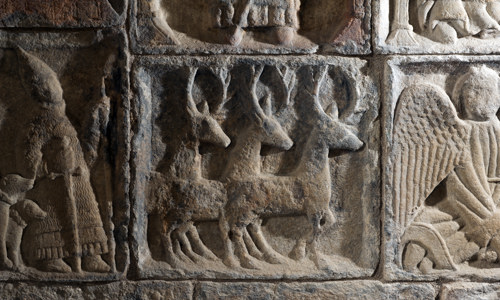
Find out more
St clement's church.
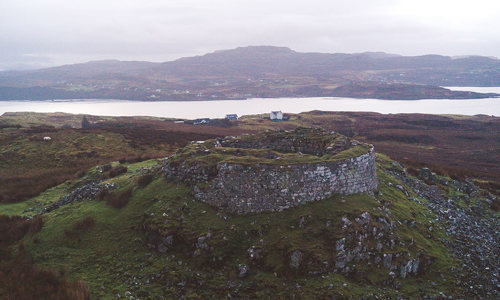
Dun Beag Broch
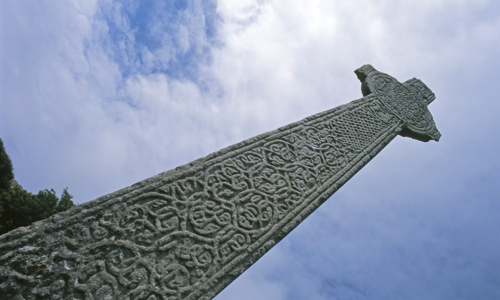
MacLean's Cross
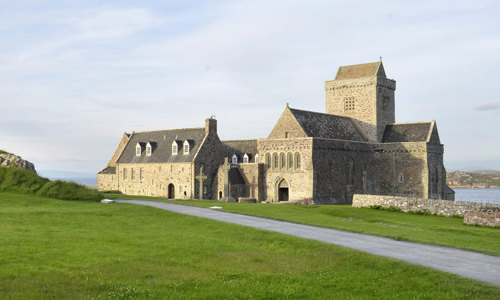
Iona Abbey and Nunnery
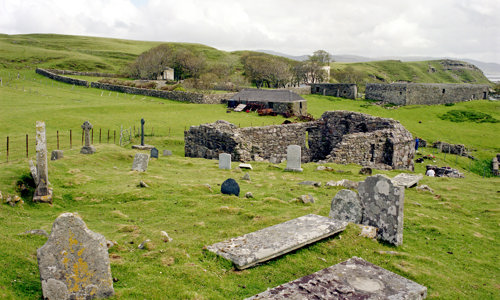
Inchkenneth Chapel

Calanais Standing Stones
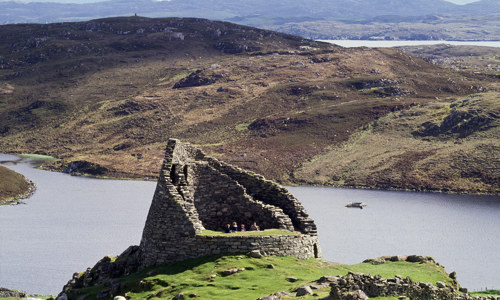
Dun Carloway
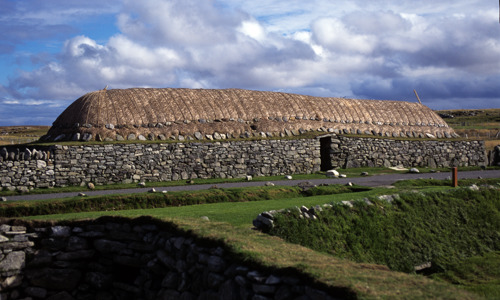

The Blackhouse, Arnol
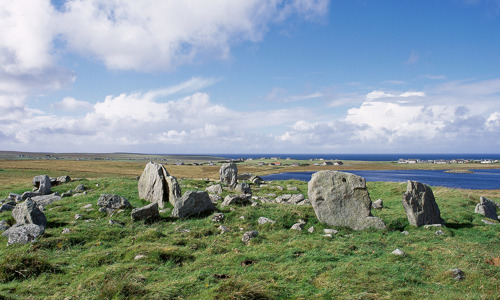
Steinacleit
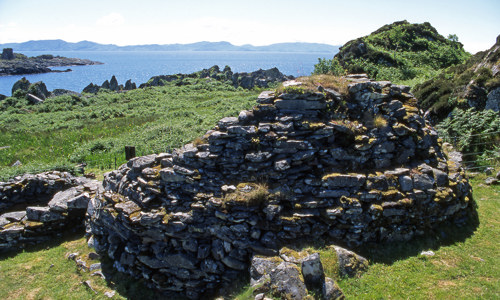
Eileach an Naoimh
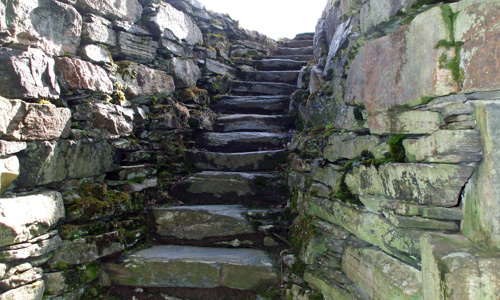
Glenelg Brochs: Dun Telve and Dun Troddan
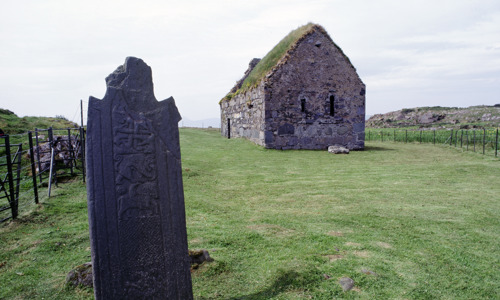
Keills Chapel and Cross
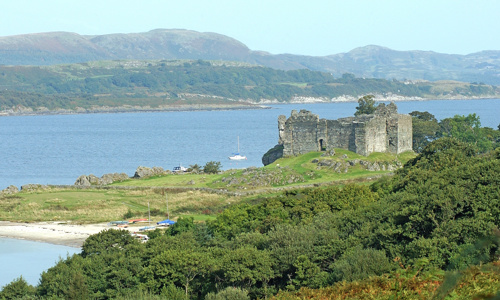
Castle Sween
Download our visitor app.
Discover more on the go – the Historic Scotland app lets you find out about Scotland’s most iconic places wherever you are.
Plan your visit
More than 20 of our sites are now open. Please book your tickets in advance.
Become a member
Join Historic Scotland to visit our properties free of charge for a full year and support our work at the same time.
Hire a site for filming
Use one of our fantastic locations on your next shoot for an awe-inspiring backdrop to your work.
Learning visits
Our 300+ historic places serve as creative inspiration for all sorts of learning activities – and for learners of all ages.
Search our events
See the past brought to life by the imaginative year-round programme of events at our properties.
Undiscovered Scotland
Kisimul castle (caisteal chiosmuil).
Kisimul or Chiosmuil translates as "the rock in the bay" and the origin is obvious from the castle's location on its rocky island in Castle Bay, on Barra's south coast. And the castle is in turn the origin of the name of Castle Bay, and that of the village of Castlebay which curves around the north side of the bay.
It had been possible to visit Kisimul Castle for many years, but only on a couple of afternoons a week. This all changed on 31 March 2000 when the Chief of the Clan MacNeil leased the castle to Historic Scotland (now Historic Environment Scotland) for 1,000 years. In doing so he ensured the work of his father to restore the castle will be safeguarded forever: and that the public can visit this remarkable building every day from April to September.
The origins of Kisimul Castle are obscure. It is possible that the rock in the bay was fortified as early as the 1000s, and there are claims that one of the courtyard buildings was originally a chapel built by St Cieran, possibly at a very early date.
But the earliest significant structures still standing today probably date back to the early 1400s. Building probably began after the granting of Barra to Gilleonan MacNeil in 1427 by Alexander, Lord of the Isles. The original design had a massive three story tower house accompanied by a curtain wall shaped to fit the rock on which the castle stands. Inside the wall a number of other structures were built, including the hall you see today and the chapel.
In the late 1400s or early 1500s a kitchen and the Tanist's House were built in a range adjoining the tower house, and the curtain wall was raised to the height you see today. This was defended by external wooden hoardings with walkways along the outside of the top of the wall. At the same time the gate was moved to its current location. Further changes were made in the 1600s including the blocking of a postern gate facing the village.
During the 1500s and 1600s Kisimul Castle successfully withstood several attempts to take it by the MacNeils' enemies, but by the mid 1700s its defensive strengths were less important than its lack of day to day comfort and convenience, and the castle was abandoned as the MacNeils' main residence.
Some time later Kisimul Castle was gutted by fire, and to make matters worse it was considered fair game as a handy source of ballast by Castlebay's thriving fishing fleet in the 1800s. By the 1930s much of the end of the castle facing the village had been destroyed, with the Tanist's House robbed out entirely and part of the curtain wall reduced to sea level.
What other Clans had failed to take from the MacNeils by force was lost in 1838 when the 40th Chief of the Clan, Roderick MacNeil became bankrupt and was forced to sell Barra to Colonel Gordon of Cluny for £38,050. Colonel Gordon, who had also acquired South Uist and Benbecula, then proceeded to clear much of the land of its tenants to make way for sheep. In 1851 most of Barra's residents were forced to board ships bound for North America, all their belongings and assets confiscated before they left.
In 1937 the American architect Robert MacNeil, who had been recognised as the 45th Clan Chief of the MacNeils, visited Barra soon after the opening of the airstrip on the island. He purchased most of the Barra estate lost to the family in 1838, including Kisimul Castle.
The following year he began to restore the castle as the family home of the MacNeils, a process that was to take until 1970 to complete. The restoration was done so well that today it is difficult to believe that significant parts of the castle date back only decades rather than centuries. It was Robert MacNeil's son, the 46th and current Clan Chief of the MacNeils, who in 2000 made over the 1,000 years lease on Kisimul Castle to Historic Scotland.
A visit to Kisimul Castle begins with a short boat trip from the pier in Castlebay to the castle's pier. For those who are used to seeing castles comprising a curtain wall with very little inside it, the first sight of the castle's courtyard is very striking. With complete ranges of buildings still standing, you get the strong sense of travelling back in time.
Before you go through the narrow gateway it's worth keeping a lookout for the structure on your left that is variously thought to be a harbour for clan galleys, or a trap designed to catch fish in the falling tide.
Much of the interior of the castle is accessible, though some of the rooms above the hall are still used by the MacNeil family. For safety reasons the top of the tower, which contains some narrow and tricky walkways, is not normally open to the public, but stunning views of Castlebay are available from the walkway around the curtain wall.
A visit to Kisimul Castle is a fascinating experience, in part because it was until recently a family home. As you wander around it's easy to overlook the 200 year period of decline and ruin. Instead what comes over is the very unusual feeling of being in a real and living castle.

Kisimul Castle

sits on a rocky island just off Castlebay and was built around 1039. Since that time, Kisimul has been the stronghold of Clan MacNeil.
It is completely surrounded by water and has never fallen to an enemy.
Kisimul Castle was abandoned in 1838 when the island was sold, and the castle's condition deteriorated. Some of its stone was used as ballast for fishing vessels, and some even ended up being used as paving in Glasgow.
The castle remains, along with most of the island of Barra, were purchased by the chief of Clan MacNeil in 1937, who in 2001 leased Kisimul to Historic Scotland for 1000 years for the annual sum of £1 and a bottle of whisky.
The boat trip from Castlebay jetty to the castle takes 5 minutes and is open Summer only and closed on Fridays.

IMAGES
VIDEO
COMMENTS
Dating from the 15th century, Kisimul is the only significant surviving medieval castle in the Outer Hebrides. Kisimul Castle is closed until further notice to allow for conservation works.
Get a taste of the history of Kisimul Castle and highlights of visiting the ‘Castle in the Sea’, the only significant medieval castle in the Western Isles. On the Isle of Barra. Hop on …
Kisimul Castle (Scottish Gaelic: Caisteal Chiosmuil) and also known as Kiessimul Castle, is a medieval castle located on a small island off Castlebay, Barra, in the Outer Hebrides, Scotland. It gets its name from the Norse ciosamul, meaning "castle island".
Delve into the history of Kisimul Castle and the Macneils, a seafaring clan, to learn about the nature of Gaelic lordship in the Middle Ages.
A towering fortress upon the tides of Castlebay and the only remaining medieval castle in the Outer Hebrides. Built in the 1400s by Clan MacNeil, Barra’s lairds at the time, Kisimul Castle is an ancient ancestral home and a tremendous day …
Kisimul Castle is the seat of the chief of Clan Macneil, who settled in Barra in the 11th century. Kisimul is known as the ‘Castle in the Sea’ due to its location on a rock in the bay, and can be accessed by taking a five minute boat trip from …
A visit to Kisimul Castle begins with a short boat trip from the pier in Castlebay to the castle's pier. For those who are used to seeing castles comprising a curtain wall with very little inside it, the first sight of the castle's courtyard is very striking.
Kisimul Castle. sits on a rocky island just off Castlebay and was built around 1039. Since that time, Kisimul has been the stronghold of Clan MacNeil. It is completely surrounded by water and has never fallen to an enemy. Kisimul …
This medieval castle was the seat of the Clan Macneil. Built in the 15th century it was…. Heaval is the highest point on the Isle of Barra at 383 metres. Neolithic people settled here around 4000 BC and built an artificial platform behind a….